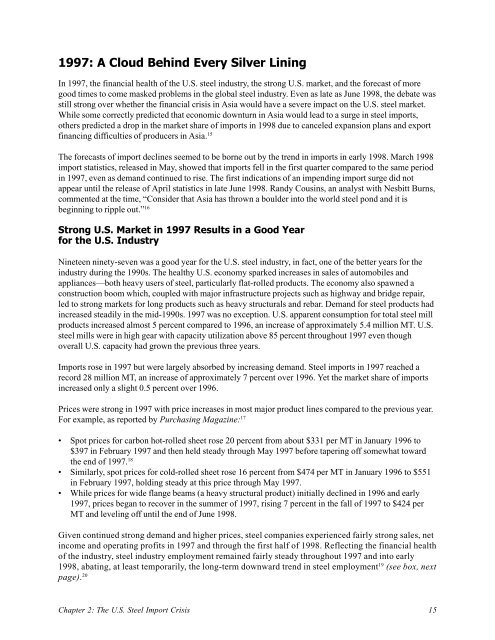Global Steel Trade; Structural Problems and Future Solutions
Global Steel Trade; Structural Problems and Future Solutions
Global Steel Trade; Structural Problems and Future Solutions
You also want an ePaper? Increase the reach of your titles
YUMPU automatically turns print PDFs into web optimized ePapers that Google loves.
1997: A Cloud Behind Every Silver Lining<br />
In 1997, the financial health of the U.S. steel industry, the strong U.S. market, <strong>and</strong> the forecast of more<br />
good times to come masked problems in the global steel industry. Even as late as June 1998, the debate was<br />
still strong over whether the financial crisis in Asia would have a severe impact on the U.S. steel market.<br />
While some correctly predicted that economic downturn in Asia would lead to a surge in steel imports,<br />
others predicted a drop in the market share of imports in 1998 due to canceled expansion plans <strong>and</strong> export<br />
financing difficulties of producers in Asia. 15<br />
The forecasts of import declines seemed to be borne out by the trend in imports in early 1998. March 1998<br />
import statistics, released in May, showed that imports fell in the first quarter compared to the same period<br />
in 1997, even as dem<strong>and</strong> continued to rise. The first indications of an impending import surge did not<br />
appear until the release of April statistics in late June 1998. R<strong>and</strong>y Cousins, an analyst with Nesbitt Burns,<br />
commented at the time, “Consider that Asia has thrown a boulder into the world steel pond <strong>and</strong> it is<br />
beginning to ripple out.” 16<br />
Strong U.S. Market in 1997 Results in a Good Year<br />
for the U.S. Industry<br />
Nineteen ninety-seven was a good year for the U.S. steel industry, in fact, one of the better years for the<br />
industry during the 1990s. The healthy U.S. economy sparked increases in sales of automobiles <strong>and</strong><br />
appliances—both heavy users of steel, particularly flat-rolled products. The economy also spawned a<br />
construction boom which, coupled with major infrastructure projects such as highway <strong>and</strong> bridge repair,<br />
led to strong markets for long products such as heavy structurals <strong>and</strong> rebar. Dem<strong>and</strong> for steel products had<br />
increased steadily in the mid-1990s. 1997 was no exception. U.S. apparent consumption for total steel mill<br />
products increased almost 5 percent compared to 1996, an increase of approximately 5.4 million MT. U.S.<br />
steel mills were in high gear with capacity utilization above 85 percent throughout 1997 even though<br />
overall U.S. capacity had grown the previous three years.<br />
Imports rose in 1997 but were largely absorbed by increasing dem<strong>and</strong>. <strong>Steel</strong> imports in 1997 reached a<br />
record 28 million MT, an increase of approximately 7 percent over 1996. Yet the market share of imports<br />
increased only a slight 0.5 percent over 1996.<br />
Prices were strong in 1997 with price increases in most major product lines compared to the previous year.<br />
For example, as reported by Purchasing Magazine: 17<br />
• Spot prices for carbon hot-rolled sheet rose 20 percent from about $331 per MT in January 1996 to<br />
$397 in February 1997 <strong>and</strong> then held steady through May 1997 before tapering off somewhat toward<br />
the end of 1997. 18<br />
• Similarly, spot prices for cold-rolled sheet rose 16 percent from $474 per MT in January 1996 to $551<br />
in February 1997, holding steady at this price through May 1997.<br />
• While prices for wide flange beams (a heavy structural product) initially declined in 1996 <strong>and</strong> early<br />
1997, prices began to recover in the summer of 1997, rising 7 percent in the fall of 1997 to $424 per<br />
MT <strong>and</strong> leveling off until the end of June 1998.<br />
Given continued strong dem<strong>and</strong> <strong>and</strong> higher prices, steel companies experienced fairly strong sales, net<br />
income <strong>and</strong> operating profits in 1997 <strong>and</strong> through the first half of 1998. Reflecting the financial health<br />
of the industry, steel industry employment remained fairly steady throughout 1997 <strong>and</strong> into early<br />
1998, abating, at least temporarily, the long-term downward trend in steel employment 19 (see box, next<br />
page). 20<br />
Chapter 2: The U.S. <strong>Steel</strong> Import Crisis 15
















